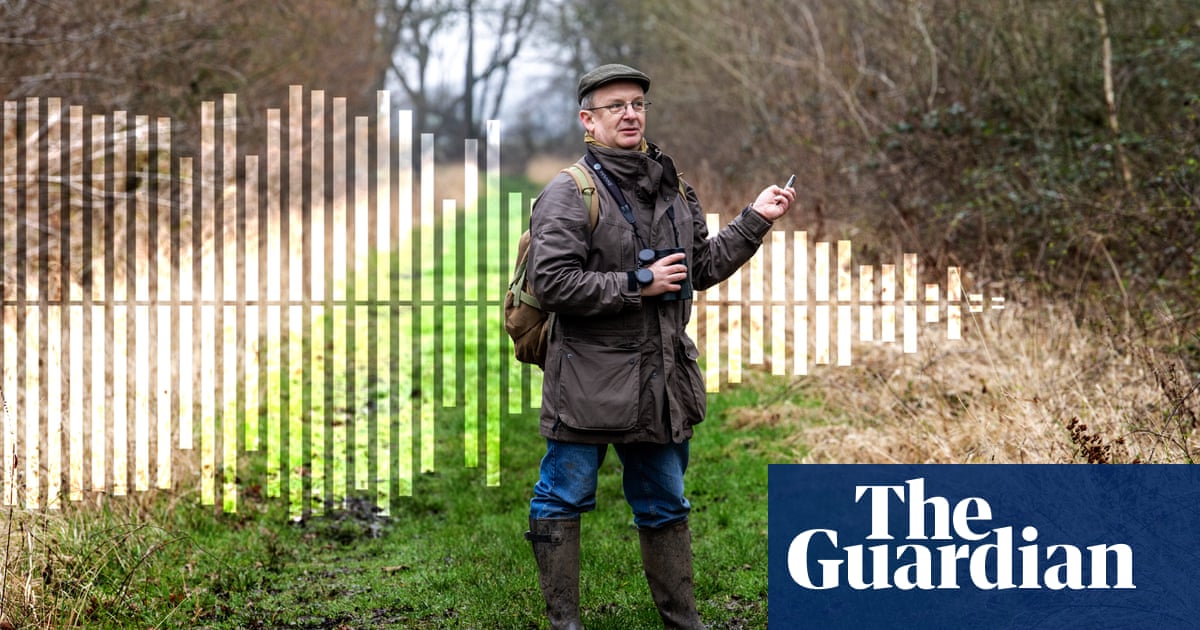
‘Why does nobody ever talk about Grimsby central library?” asks Owen Hatherley with an air of mild outrage. “How is it not famous? It’s a fabulous little building, with chandeliers, mosaics, public sculpture, a wonderful double-height reading room. It’s a fantastic place but it’s not listed. It’s never ever mentioned.”
Hatherley stumbled upon the little concrete jewel box, which was built in 1968 by JM Milner for the Grimsby borough architects department, while researching his latest book, a hefty 600-page gazetteer of Modern Buildings in Britain. Entering the classically inspired block of prefabricated concrete panels, under a sculptural honeycomb grid ceiling, he found a world of swirling mosaics and abstract tapestries illuminated by chic 1960s lighting in clustered tubes – a pristine example of “civic design of the highest order” in this neglected northern town.
It is one of many such unexpected entries in the book, which roams voraciously from Aberystwyth to Aberdeen in search of those remarkable everyday products of the modern movement that are often hiding in plain sight. The famous favourites are all in there too, from Lasdun and Goldfinger to the New Towns, given entertaining new appraisals in Hatherley’s characteristically bolshie prose. But there are new finds for even the most hardcore concrete caressers.
“I didn’t want the book to be about iconic buildings,” says Hatherley, “the way people tend to look at modern architecture as being about great objects in big cities, thanks to the cult of brutalism. For a start, most of the iconic architecture we’ve got in this country is not very good. Famous architects have very seldom done their best work here. Often the most interesting stuff is the more mundane.”
When he was first approached by Penguin to write the guide, he thought he could probably do it in a year. It sounds about right for the prolific 40-year-old, who has published 14 books to date, several of which have covered similar ground. But it ended up growing into a six-year project. He began by combing through Pevsner guides, back issues of the Modernist and C20 Magazine, and trawling Instagram feeds before criss-crossing the country by train and bus, with occasional lifts from friends and family who drive. The aim was not an exhaustive, scholarly documentation of modernism in Britain but an approachable guide to accessible, or at least visible, things to go and see.
“I tried to find a decent modern building in every settlement in the country, which was really quite gruelling,” he says. “The idea was that everywhere probably does have one or two good modern buildings – even Reading. No matter whether you’re in Scunthorpe or Chandlers Ford or East Kilbride, there should be something interesting that you can go and look at.” The one building he singles out in Reading is the university’s school of construction management and engineering, designed by Howell Killick Partridge & Amis in 1973, known locally as the Lego building for its kit-of-parts look. In Hatherley’s eyes, it is “the Katsura Palace in coloured concrete”.
It is an addictive book to dip in and out of, to open at random to learn something new. In Preston, as well as the once threatened, now cherished bus station, you can find the Plastic Classroom at Kennington Road primary school, a faceted white dome built in 1974 that looks more like something from a Kubrick film set than a municipal architects’ department. In Swansea, Hatherley finds “one of the most admirable examples of civic brutalism in Britain,” in the form of the 1980s civic centre – which is currently slated for demolition, like a good number of buildings in the book.
Shetland, meanwhile, turns out to be a site of some remarkably progressive public housing, with colourful eco-friendly homes designed by Richard Gibson that seem more akin to what you might find in Norway. Like its cousins across the water, Hatherley notes, Shetland has used its oil revenue to build a Scandi-style social democratic state-within-a-state, with great public buildings and attractive social housing. He steers clear of politics as far as possible but the overarching message is clear: the best modern architecture is always the product of a strong welfare state.
“There are certain points at which the rest of the country outside London just disappears from serious architecture,” he says. “And the reason is always the same: at each point, whether it’s the 1920s and 30s or the 1980s and 90s, or the last 10 years, you have a Conservative government that doesn’t give a shit about the rest of the country and lets them die.”
He begins his introduction – which is possibly the most lucid and concise history of modern architecture in Britain you will find anywhere – at the St Mary’s estate in Woolwich, south London; a typical product of 1950s council housing where he lived when he began writing the book.
You wouldn’t normally give it a second look. With brown brick walls and shallow pitched roofs dotted with chimneys, it exemplifies “people’s detailing” – a waspish term, Hatherley explains in a handy glossary, used for the sort of communist-aligned, Swedish-influenced, picturesque modernism of the decade after the second world war. But modern architecture in Britain, he writes, is all about places like this. No matter how mundane they may seem, they are expressions of a revolutionary approach to who builds in the city, how they build and in whose interest.
Many of Hatherley’s opinions, on both aesthetics and politics, will be familiar to readers who know his work, but there are some surprising, unpredictable judgments. While he is mostly full of contempt for postmodernism (“the ‘funny tie’ in the Brooks Brothers corporate cityscape”), he finds a lot to love in the eccentric buildings of Alan Short, whose “riotous” 1990s university projects, which writhe with clashing materials and wayward ventilation towers, are “packed with thrills and spills”.
Hatherley is also partial to the polychrome excess of John Outram, particularly the Judge Institute, which he calls “a ridiculous and exhilarating ride, Thatcherite sci-fi, and the most gleefully tasteless building in Cambridge.” Similarly, you might expect Hatherley to have nothing but scorn for the “pseudomodernism” of the New Labour era, but he loves much of Will Alsop’s work, applauding the “mastery of monumentality” of his hulking Palestra office block in Southwark, London.
He is also an unlikely fan of Norman Foster’s globular Sage concert hall in Gateshead, and finds lots to admire in Kengo Kuma’s colossal V&A Dundee, which he thinks is “wholly of its place” and full of “smart and subtle ideas” inside. Elsewhere, he is refreshingly honest about his love-hate relationship with certain structures: the Shard skyscraper in London is “a shocker” at street level but, by night, its eerie silhouette is “a sinister and glowering masterwork”.
With the aim of producing a guide of things worth going to see, Hatherley says he hasn’t included anything he hates, although there are plenty of entertaining swipes at nearby structures. While praising the Charles Street car park in Sheffield he condemns the Conran-designed St Paul’s Tower alongside as “pitifully underdesigned … an utterly trivial piss-weak extruded grid of brown luxury flats”. In Manchester he finds the Beetham Tower to be the only work by Ian Simpson worth naming, compared to his other towers that exhibit an “unfortunate combination of over-slick glass gloop and a fumbling approach to form”. Pretty much every recent tower in the city could be demolished tomorrow, adds the author, without anyone missing them. It’s true.
Given the current state of contemporary construction in Britain, it’s not hard to see why Hatherley prefers to dwell on the products of more enlightened times. Is he optimistic about the current direction of architecture on these isles?
“No,” he says bluntly. “But the thing that’s wrong with British architecture isn’t to do with style or fashion, it’s to do with the fact that everything here is incredibly badly built, thanks to a procurement culture based on the endless deferring of risk. It’s evident in the Grenfell inquiry: there were dozens of contractors, just to refurbish a tower block, with labyrinthine contracts to ensure there was no risk to those companies. The first thing that’s always driven down is quality – and people have died because of it. Until we get rid of PFI [private finance initiative], and something is done to raise the quality of mass housing, schools and hospitals, I don’t have much hope for British architecture.”
Modern Buildings in Britain: A Gazetteer by Owen Hatherley is published by Penguin on 7 April.












